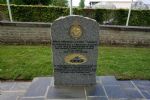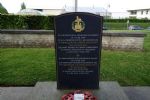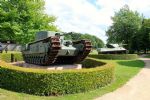Aérodrome A-13
Le premier terrain à 2 pistes d'envol. Le 2 Juillet, le 833rd Engineer Aviation Battalion du Lt CoL Gait reçut son affectation au 926th Engineer Aviation Regiment dont l'état-major était établi près de Chef du Pont dans la Manche. La plus grande partie du bataillon avait débarqué le 30 Juin à Omaha tandis qu'un élément léger motorisé débarquait dans le même temps à Utah Beach.
Tout le bataillon se rassembla près de Chef du Pont. Le 3 juillet la Compagnie C reçut la responsabilité de l'entretien de la piste en SMT de A-6 à Beuzeville ainsi que des 75 emplacements pour avion. Ils avaient égaiement pour mission d'en construire 10 supplémentaires ainsi qu'une vole d'accès et d'installer 2 cuves d'essence de 4000 litres. Le même jour, la Compagnie B fut chargée de la maintenance de A-7 à Fontenay/Azeville ainsi que d'établir une gravière destinée à fournir les graviers pour boucher les fossés afin d'essayer de porter peu à peu la piste aux nouvelles dimensions pour chasseurs-bombardiers.
Le 12 juillet alors que tous les bataillons du 922nd E.A.R. étalent occupés par ailleurs, le 833rd du 926th regiment fut envoyé à Tour en Bessin dans le Calvados pour y construire le premier terrain pour bombardiers moyens qui allait prendre le nom de A-13. Ce terrain devrait être constitué de 2 pistes de 1525 m par 40 entièrement recouvertes de PSP (plaques d'acier percées), d'un réseau de taxiways et de routes d'accès ainsi que d'emplacements en SMT pour y parquer 75 avions. A l'exception d'un peloton de la compagnie B et de 2 pelotons de la compagnie C retenus respectivement sur A-7 et A-6, tout le bataillon se consacra à la construction de ce nouveau terrain. Le travail fut accompli en 16 Jours. Le 26 juillet le bataillon recevra l'aide du 846th E.A.B. du MaJor WJ. Battisson débarqué le 16 Juillet. A la date prévue au départ pour sa mise en service, le 28 juillet, les pistes, les aires de rassemblement, les taxiways, les aires de stationnement ainsi que l'installation de 2 réservoirs de 4000 litres pour l'essence et l'eau étaient terminés dans le périmètre réquisitionné pour le terrain équipé d'un réseau électrique minimum pour les communications et l'éclairage du camp. A-13 était le premier aérodrome à 2 pistes entièrement construit en France par l'Armée des Etats-Unis et le premier à avoir ses pistes entièrement revêtues de PSP. C'était également le premier dont l'emplacement avait été décidé uniquement à la suite de reconnaissances aériennes. Mais la grande fierté du Bataillon était de l'avoir construit malgré l'avis défavorable des britanniques qui avalent déclaré qu'il était impossible de construire des pistes d'envol à cet endroit, extrême limite du secteur américain, la rivière Drôme bordant les installations marquant la limite entre les 2 secteurs. Des tentes étaient dressées pour le cantonnement et pour l'Intendance et un dépôt de matériel et de munitions furent créés le long de l'actuelle départementale 100, route d'accès élargie ouverte en utilisant le tracé du réseau pré-existant. Le travail effectué le bataillon fit mouvement sur Bolleville pour la construction du terrain A-25 C. Du 19 Juillet au 19 août, A-13 fut le terrain des P-47 du 373rd Fighter Group qu'ils partagèrent à partir du 5 août avec ceux du 406th F.G Quand, dans le cadre du redéploiement du XIX Tactical Air Command couvrant l'avancée de la TOSA, les 2 groupes de chasse appartenant au 303rd Wing quittèrent le terrain, Ils furent remplacés par les Martin B-26 Marauders du 394th Bombardment Group. Ces bombardiers moyens y demeurèrent Jusqu'au 18 septembre soit un mois d'occupation des Installations. Une fois les avions partis, les installations furent utilisées comme dépôt de ravitaillement et terrain d'évacuation sanitaire Jusqu'au 2 décembre où il fut rendu aux autorités françaises. Aujourd'hui l'emprise des pistes est encore visible lorsqu'on parcourt les champs et qu'on se rend compte du manque de déclivité naturelle de certains d'entre eux par rapport à la pente naturelle du terrain. De plus lorsque qu'on se met dos au monument érigé au bord de l'ancienne nationale 13, on peut se rendre compte de son orientation en observant la rupture de continuité dans l'entrelacs de hales recouvrant l'endroit
Le 373rd FIGHTER GROUP
Le 373rd Fighter Group a été créé le 25 mal 1943. Envoyé en Angleterre en mars-avril 44, il est affecté, au cours de la première semaine d'avril, directement au 303rd Wing du XIX Tactical Air Command de la 9th Air Force. Ses quelque 70 chasseurs prennent alors leurs quartiers à Woodchurch. Le 8 mal 44, il effectue sa première mission, un swap au-dessus de la Normandie. Ensuite il prendra part aux activités préparant le Débarquement en escortant les B-26 qui pilonnaient les infrastructures routières et aériennes en France alternant missions d'escorte et missions de bombardement en piqués afin d'acquérir de l'expérience. Le 6 Juin, le Group était affecté à la couverture des plages et les Jours qui suivirent à celle du front par des mitraillages à basse altitude. Durant leur séjour en Angleterre, les pilotes du Colonel William FISchwartz furent crédités de 30 victoires aériennes pour 15 pertes. Le 19 Juillet le Group était transféré sur A 13,il y sera au complet à la fin du mois. A partir de là, sa tâche essentielle fut d'empêcher les renforts ennemis d'arriver dans la région de St Lô où les troupes au sol avalent rompu le front le 25 Juillet. Ils ne cessèrent de harceler l'ennemi Jusque dans la poche de Falaise-Argentan-Trun-Chambols. Le 19 août, fl est transféré à St James, non loin d'Avranches, sur A-29, terrain plus proche de la 3ème Armée à laquelle il est rattaché. Le 19 septembre, il quitte définitivement la Normandie pour A-620 à Reims. Durant sa période normande, il aura reçu sa première décoration : la Croix de Guerre française avec palme.
Le 406th FIGHTER GROUP «The Raider Group»
Créé en tant que Group de bombardement (en piqué) le 4 février 1943,11 fut requalifié sous le nom de 406th Fighter Group en Mal 1944. Les pilotes, venant de différents horizons et surtout d'Afrique du Nord reçurent leurs P 47 le ler décembre 1943. Après quelques mois d'entraînement lis rejoignirent l'Europe à Ashford dans le Kent. Déclaré opérationnel le 8 mal 1944, le Group accomplit sa première mission au sein de la 9th Air Force le lendemain au dessus de la Normandie. Chasse, escorte de bombardiers et bombardements en piqué ne cessèrent de se succéder quotidiennement Jusqu'au JourJ où lifut affecté à la couverture des opérations sur Utah-Beach. Quatre missions par jour étalent assurées par chaque squadron du groupe dont les avions se relayaient pour être constamment au-dessus des plages. La couverture de la plage d'Utah se déroula sans histoire. Après la première semaine, le groupe effectua des reconnaissances armées, bombardements en piqués sur des objectifs variés tels les véhicules de transport, les emplacements d'artillerie, les dépôts de munitions, les voies ferrées, les gares de triage et les ponts. Ce fut son travail durant toute la Campagne de Normandie. La première opération tactique d'envergure que le groupe eut à mener fut sur les points de résistance de Cherbourg en Juillet Les résultats furent bons malgré la perte de 5 avions et de 3 pilotes. Créé le 15 février 1943, le 394th Bombardment Group (medium) fut activé le 5 mars sur Manin 8.26 Marauder puis envoyé en Angleterre en février-mars 1944 directement dans la 9th Air Force tactique. En mars 1944, ses avions entrèrent dans en combats préparatifs au débarquement en bombardant sites gares de triage, ponts, aérodromes, emplacements d'artillerie et tous objectifs susceptibles de servir l'ennemi. Le 6 juin, il bombarda les installation de défense de Cherbourg puis, ensuite tous les objectifs qui lui furent assignés dans le cadre de la Bataille de Normandie, Le 25 Juillet Il participa à la bataille deSaint-Lô. Du 7 au 9 août, il se distingua par un bombardement particulièrement efficace d'objectifs particulièrement fortifiés dans le Nord de la France. Le 25 août, le 394th Group se posa sur A-13 venant de Holmsley dans le Hampshire. il y restera Jusqu'au 15 septembre, date à laquelle H partira à Orléans-Bricy (A-50) A partir de la Normandie, le group e participa aux bombardements des points de résistance en Bretagne et à Brest en particulier puis commença à opérer sur l'Allemagne en larguant notamment des tracts (leaflets) destinés à affaiblir le moral de l'ennemi. Décorations obtenues : Distinguished Unit Citation pour les opérations du 7 au 9 août 1944 Croix de Guerre Française avec palme pour son rôle joué dans la Libération de la France du 6 juin au 14 septembre 1944.






